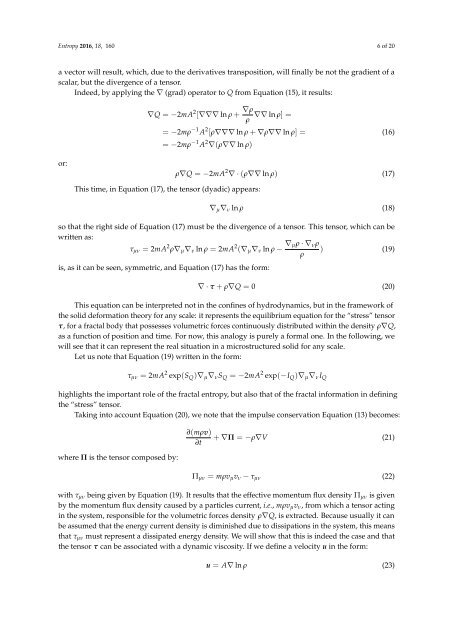entropy-18-00160
You also want an ePaper? Increase the reach of your titles
YUMPU automatically turns print PDFs into web optimized ePapers that Google loves.
Entropy 2016, <strong>18</strong>, 160 6 of 20<br />
a vector will result, which, due to the derivatives transposition, will finally be not the gradient of a<br />
scalar, but the divergence of a tensor.<br />
Indeed, by applying the ∇ (grad) operator to Q from Equation (15), it results:<br />
∇Q = −2mA 2 [∇∇∇ ln ρ + ∇ρ ∇∇ ln ρ] =<br />
ρ<br />
= −2mρ −1 A 2 [ρ∇∇∇ ln ρ + ∇ρ∇∇ ln ρ] = (16)<br />
= −2mρ −1 A 2 ∇(ρ∇∇ ln ρ)<br />
or:<br />
ρ∇Q = −2mA 2 ∇ · (ρ∇∇ ln ρ) (17)<br />
This time, in Equation (17), the tensor (dyadic) appears:<br />
∇ µ ∇ ν ln ρ (<strong>18</strong>)<br />
so that the right side of Equation (17) must be the divergence of a tensor. This tensor, which can be<br />
written as:<br />
τ µν = 2mA 2 ρ∇ µ ∇ ν ln ρ = 2mA 2 (∇ µ ∇ ν ln ρ − ∇ µρ · ∇ ν ρ<br />
) (19)<br />
ρ<br />
is, as it can be seen, symmetric, and Equation (17) has the form:<br />
∇ · τ + ρ∇Q = 0 (20)<br />
This equation can be interpreted not in the confines of hydrodynamics, but in the framework of<br />
the solid deformation theory for any scale: it represents the equilibrium equation for the “stress” tensor<br />
τ, for a fractal body that possesses volumetric forces continuously distributed within the density ρ∇Q,<br />
as a function of position and time. For now, this analogy is purely a formal one. In the following, we<br />
will see that it can represent the real situation in a microstructured solid for any scale.<br />
Let us note that Equation (19) written in the form:<br />
τ µν = 2mA 2 exp(S Q )∇ µ ∇ ν S Q = −2mA 2 exp(−I Q )∇ µ ∇ ν I Q<br />
highlights the important role of the fractal <strong>entropy</strong>, but also that of the fractal information in defining<br />
the “stress” tensor.<br />
Taking into account Equation (20), we note that the impulse conservation Equation (13) becomes:<br />
where Π is the tensor composed by:<br />
∂(mρv)<br />
∂t<br />
+ ∇Π = −ρ∇V (21)<br />
Π µν = mρv µ v ν − τ µν (22)<br />
with τ µν being given by Equation (19). It results that the effective momentum flux density Π µν is given<br />
by the momentum flux density caused by a particles current, i.e., mρv µ v ν , from which a tensor acting<br />
in the system, responsible for the volumetric forces density ρ∇Q, is extracted. Because usually it can<br />
be assumed that the energy current density is diminished due to dissipations in the system, this means<br />
that τ µν must represent a dissipated energy density. We will show that this is indeed the case and that<br />
the tensor τ can be associated with a dynamic viscosity. If we define a velocity u in the form:<br />
u = A∇ ln ρ (23)



